Abstract
During the 1971 epidemic of Venezuelan equine encephalomyelitis (VEE) in south Texas, 203 suspect VEE cases were evaluated by the Center for Disease Control. Sixty-seven were confirmed as cases of VEE. Laboratory confirmation was accomplished by isolation of VEE virus from a serum specimen taken during the acute illness in 50 (75%) of the confirmed cases. Serological confirmation was obtained in 17 cases (25%). Virus isolations were most often obtained from sera collected during the first 3 days of illness. Peak serum virus titers (algebraic mean, 10(5-7) suckling mouse intracranial 50% lethal doses [SMICLD50] per ml) occurred on day 2 of illness. One-half of the sera from which virus was isolated contained at least 10(5) SMICLD50/ml, which has been shown to be sufficient to infect some vector mosquitoes. Blood from 13 virus-positive VEE cases was obtained 1 and 11 months after illness. Hemagglutination-inhibiting, complement-fixing, and neutralizing antibodies were formed by all 13 patients 1 month after illness. Hemagglutination-inhibiting antibody titers were essentially unchanged 11 months after illness. Complement-fixing antibody was undetectable 11 months after illness in 23% of cases and was detectable at dilutions of 1:8 or 1:6 in 77%. Neutralizing antibody (measured by log neutralization index) was not detectable 1 year after illness in one person (8%); titers had declined from 1.0 to 2.0 in 46%, were unchanged in 39%, and were not tested in one person (8%). No evidence of intrafamilial spread of VEE virus was obtained in either of two illness and antibody surveys. A randomized household illness and antibody survey of 681 Port Isabel residents revealed an inapparent infection ratio of 1:11 and an overall antibody prevalence of 3.2%.
Full text
PDF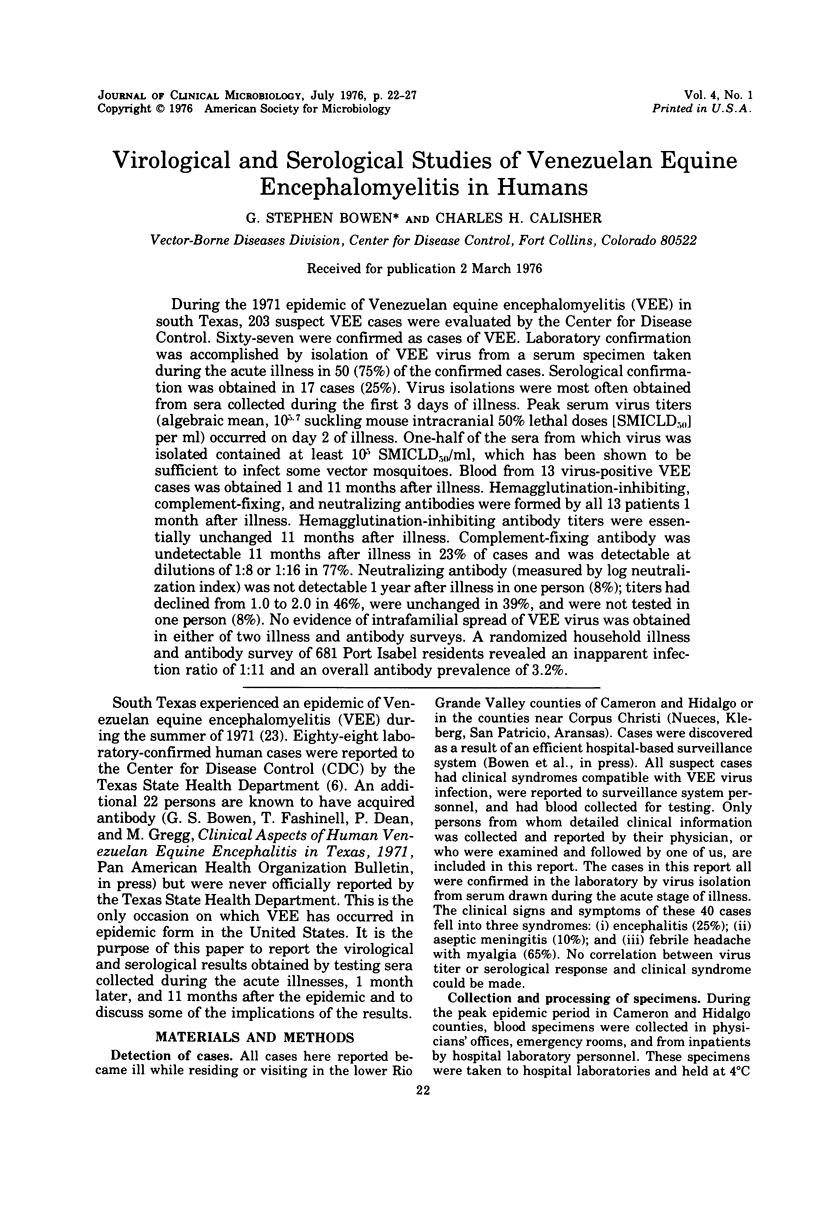
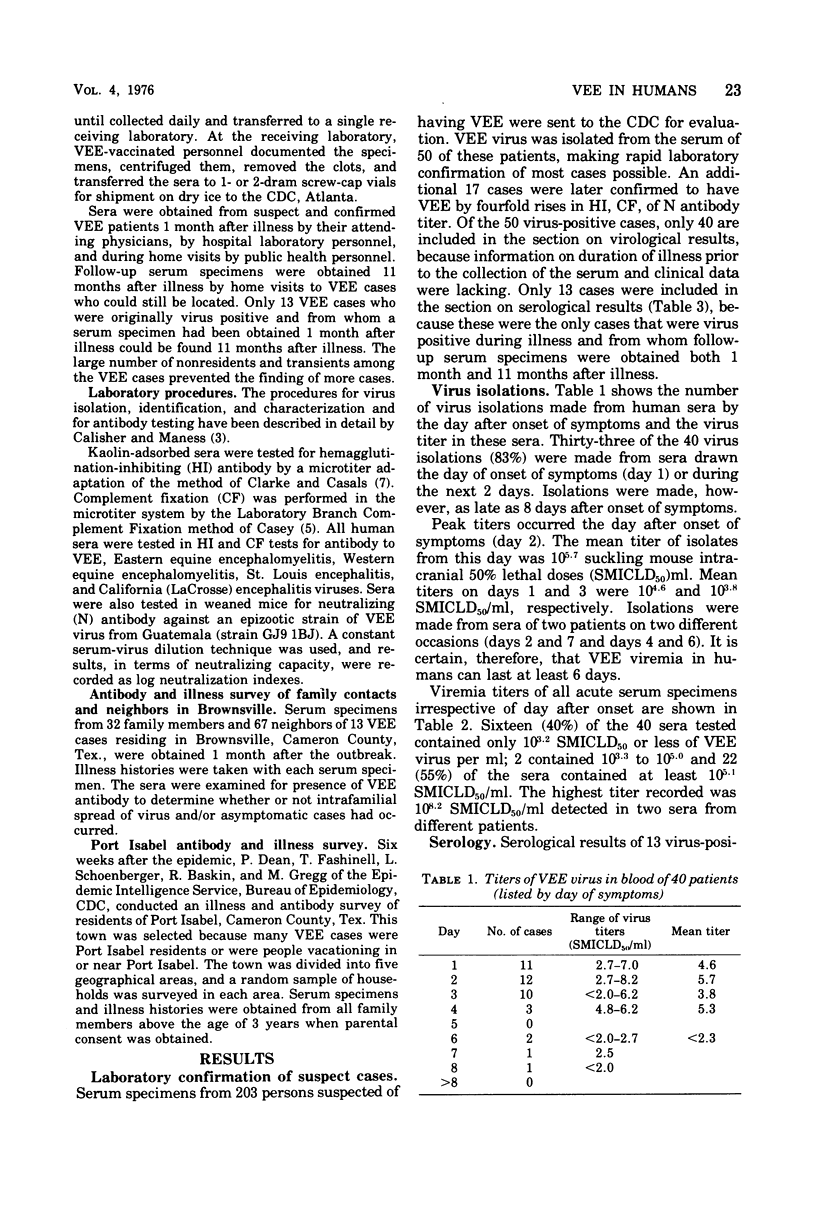
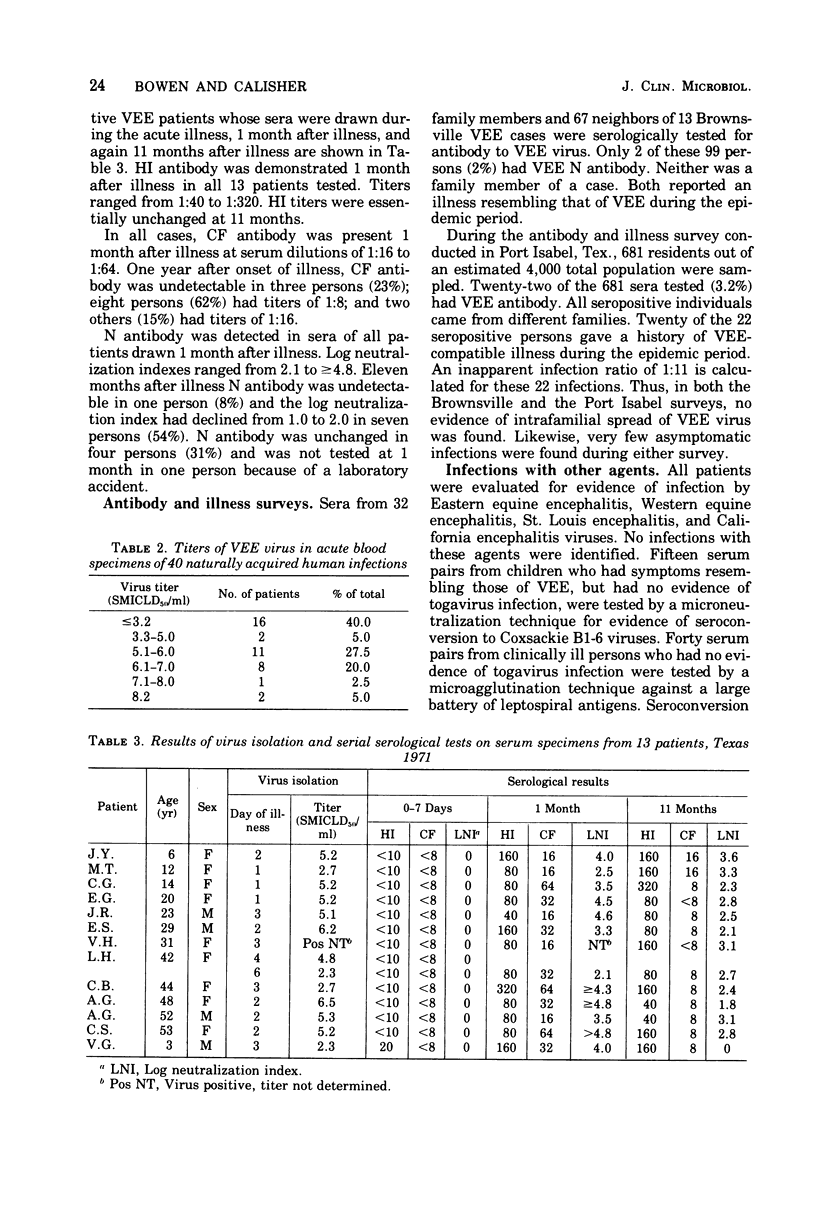
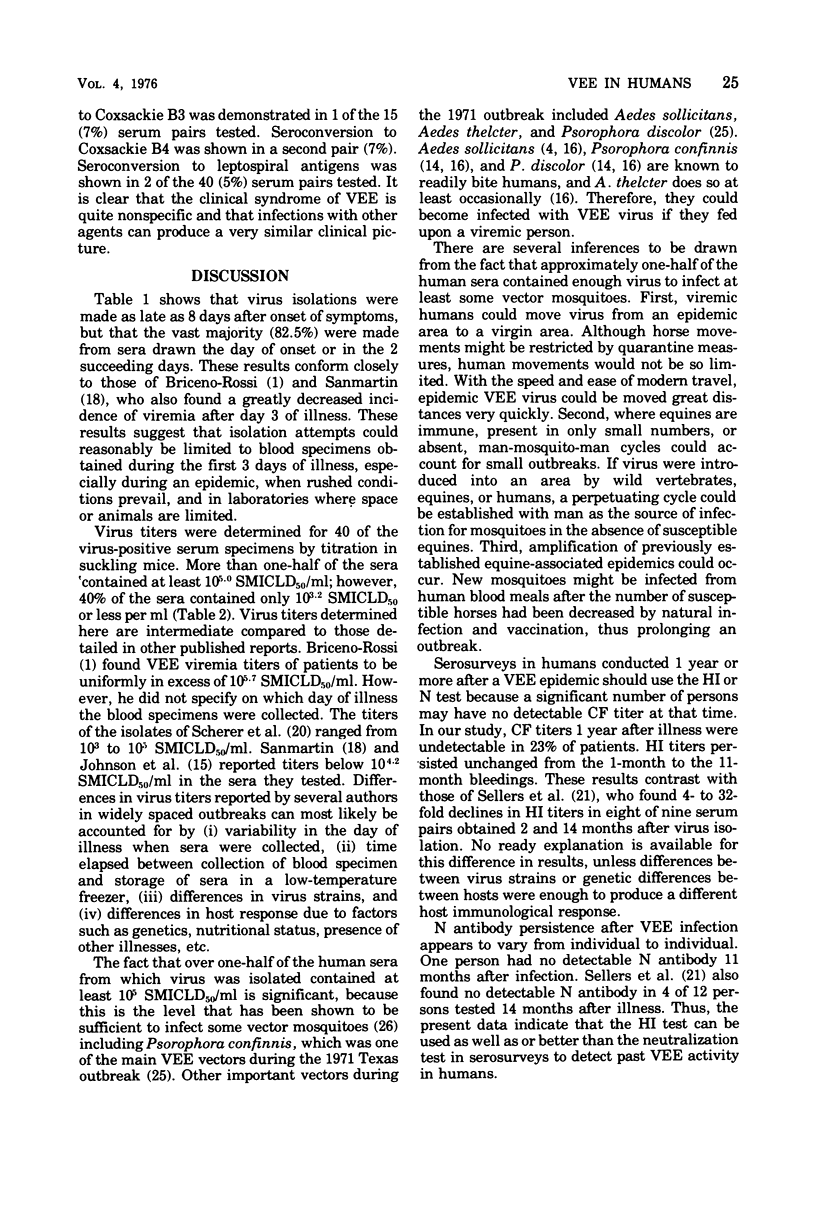

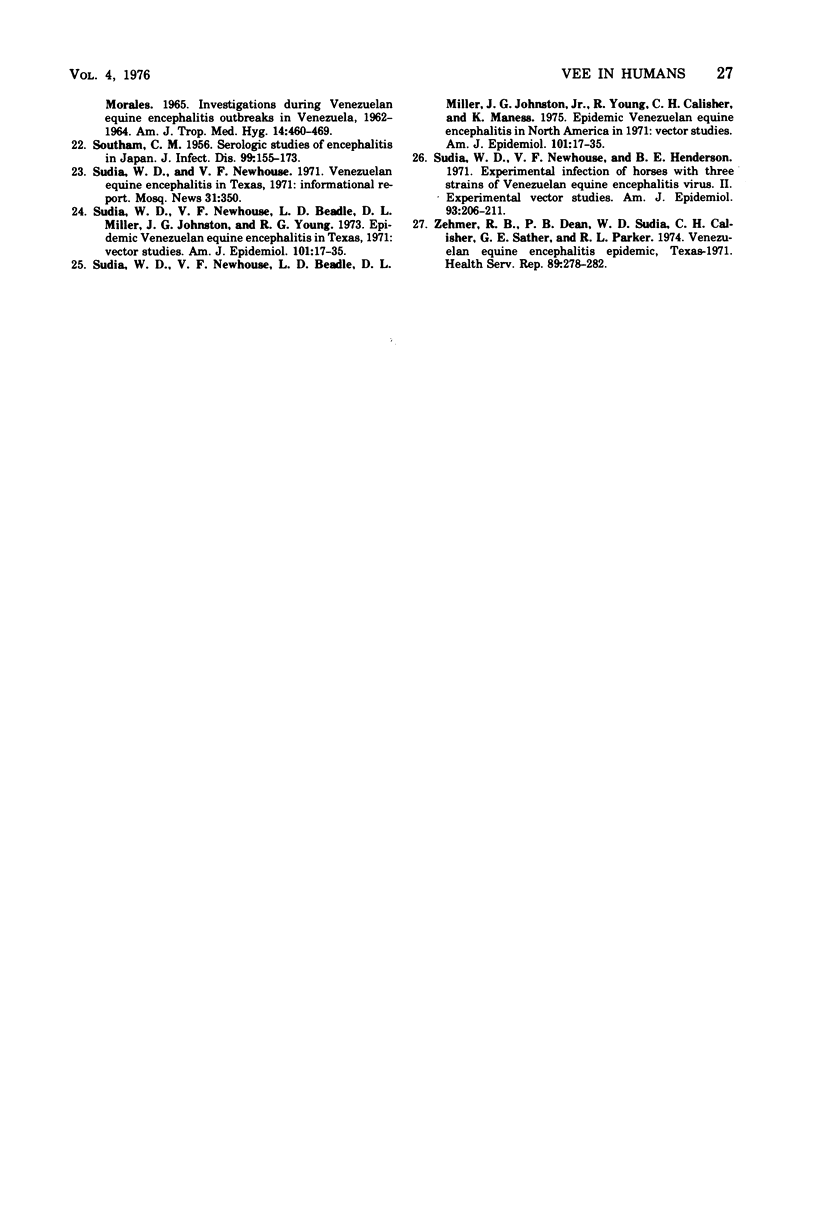
Selected References
These references are in PubMed. This may not be the complete list of references from this article.
- BRODY J. A., BROWNING G. An epidemic of St. Louis encephalitis in Cameron County, Texas, in 1957. Am J Trop Med Hyg. 1960 Jul;9:436–443. doi: 10.4269/ajtmh.1960.9.436. [DOI] [PubMed] [Google Scholar]
- CLARKE D. H., CASALS J. Techniques for hemagglutination and hemagglutination-inhibition with arthropod-borne viruses. Am J Trop Med Hyg. 1958 Sep;7(5):561–573. doi: 10.4269/ajtmh.1958.7.561. [DOI] [PubMed] [Google Scholar]
- Calisher C. H., Maness K. S. Laboratory studies of Venezuelan equine encephalitis virus in equines, Texas, 1971. J Clin Microbiol. 1975 Sep;2(3):198–205. doi: 10.1128/jcm.2.3.198-205.1975. [DOI] [PMC free article] [PubMed] [Google Scholar]
- FROESCHLE J. E., REEVES W. C. SEROLOGIC EPIDEMIOLOGY OF WESTERN EQUINE AND ST. LOUIS ENCEPHALITIS VIRUS INFECTION IN CALIFORNIA. II. ANALYSIS OF INAPPARENT INFECTIONS IN RESIDENTS OF AN ENDEMIC AREA. Am J Epidemiol. 1965 Jan;81:44–51. doi: 10.1093/oxfordjournals.aje.a120496. [DOI] [PubMed] [Google Scholar]
- Franck P. T., Johnson K. M. An outbreak of Venezuelan encephalitis in man in the Panamá Canal Zone. Am J Trop Med Hyg. 1970 Sep;19(5):860–865. doi: 10.4269/ajtmh.1970.19.860. [DOI] [PubMed] [Google Scholar]
- Gutierrev E., Monath T. P., Alava A., Uriguen D., Arzube M., Chamberlain R. W. Epidemiologic investigations of the 1969 epidemic of Venezuelan encephalitis in Ecuador. Am J Epidemiol. 1975 Nov;102(5):400–413. doi: 10.1093/oxfordjournals.aje.a112179. [DOI] [PubMed] [Google Scholar]
- Henderson B. E., Pigford C. A., Work T., Wende R. D. Serologic survey for St. Louis encephalitis and other group B arbovirus antibodies in residents of Houston, Texas. Am J Epidemiol. 1970 Jan;91(1):87–98. doi: 10.1093/oxfordjournals.aje.a121116. [DOI] [PubMed] [Google Scholar]
- Hinman A. R., McGowan J. E., Jr, Henderson B. E. Venezuelan equine encephalomyelitis: surveys of human illness during an epizootic in Guatemala and El Salvador. Am J Epidemiol. 1971 Feb;93(2):130–136. doi: 10.1093/oxfordjournals.aje.a121233. [DOI] [PubMed] [Google Scholar]
- Johnson K. M., Shelokov A., Peralta P. H., Dammin G. J., Young N. A. Recovery of Venezuelan equine encephalomyelitis virus in Panama. A fatal case in man. Am J Trop Med Hyg. 1968 May;17(3):432–440. doi: 10.4269/ajtmh.1968.17.432. [DOI] [PubMed] [Google Scholar]
- LAVECK G. D., WINN J. F., WELCH S. F. Inapparent infection with western equine encephalitis virus: epidemiologic observations. Am J Public Health Nations Health. 1955 Nov;45(11):1409–1416. doi: 10.2105/ajph.45.11.1409. [DOI] [PMC free article] [PubMed] [Google Scholar]
- Rossi A. L. Rural epidemic encephalitis in Venezuela caused by a group A arbovirus (VEE). Prog Med Virol. 1967;9:176–203. [PubMed] [Google Scholar]
- SANMARTIN-BARBERI C., GROOT H., OSORNO-MESA E. Human epidemic in Colombia caused by the Venezuelan equine encephalomyelitis virus. Am J Trop Med Hyg. 1954 Mar;3(2):283–293. doi: 10.4269/ajtmh.1954.3.283. [DOI] [PubMed] [Google Scholar]
- SELLERS R. F., BERGOLD G. H., SUAREZ O. M., MORALES A. INVESTIGATIONS DURING VENEZUELAN EQUINE ENCEPHALITIS OUTBREAKS IN VENEZUELA--1962-1964. Am J Trop Med Hyg. 1965 May;14:460–469. doi: 10.4269/ajtmh.1965.14.460. [DOI] [PubMed] [Google Scholar]
- SOUTHAM C. M. Serologic studies of encephalitis in Japan. I. Hemagglutination-inhibiting, complement-fixing, and neutralizing antibody following overt Japanese B encephalitis. J Infect Dis. 1956 Sep-Oct;99(2):155–162. doi: 10.1093/infdis/99.2.155. [DOI] [PubMed] [Google Scholar]
- Scherer W. F., Ordonez J. V., Jahrling P. B., Pancake B. A., Dickerman R. W. Observations of equines, humans and domestic and wild vertebrates during the 1969 equine epizootic and epidemic of Venezuelan encephalitis in Guatemala. Am J Epidemiol. 1972 Mar;95(3):255–266. doi: 10.1093/oxfordjournals.aje.a121393. [DOI] [PubMed] [Google Scholar]
- Sudia W. D., Newhouse V. F., Beadle I. D., Miller D. L., Johnston J. G., Jr, Young R., Calisher C. H., Maness K. Epidemic Venezuelan equine encephalitis in North America in 1971: vector studies. Am J Epidemiol. 1975 Jan;101(1):17–35. doi: 10.1093/oxfordjournals.aje.a112068. [DOI] [PubMed] [Google Scholar]
- Sudia W. D., Newhouse V. F., Henderson B. E. Experimental infection of horses with three strains of Venezuelan equine encephalomyelitis virus. II. Experimental vector studies. Am J Epidemiol. 1971 Mar;93(3):206–211. doi: 10.1093/oxfordjournals.aje.a121247. [DOI] [PubMed] [Google Scholar]
- Zehmer R. B., Dean P. B., Sudia W. D., Calisher C. H., Sather G. E., Parker R. L. Venezuelan equine encephalitis epidemic in Texas, 1971. Health Serv Rep. 1974 May-Jun;89(3):278–282. [PMC free article] [PubMed] [Google Scholar]


